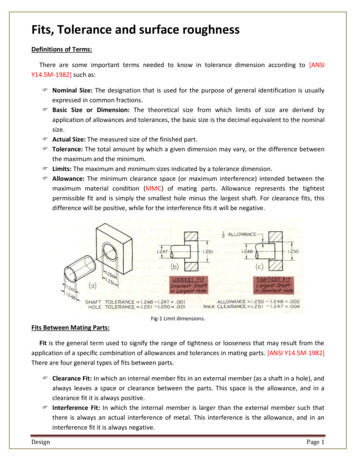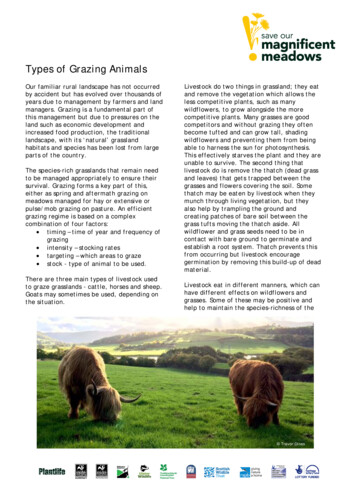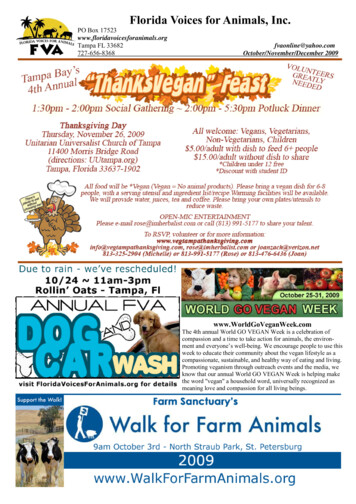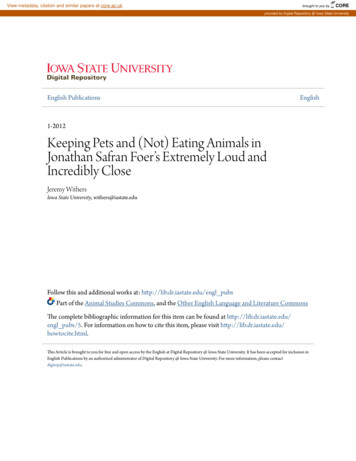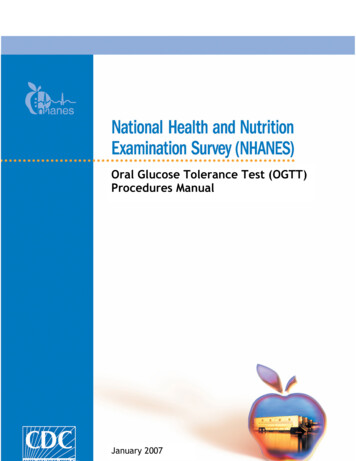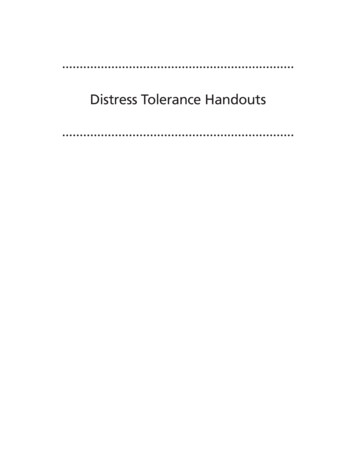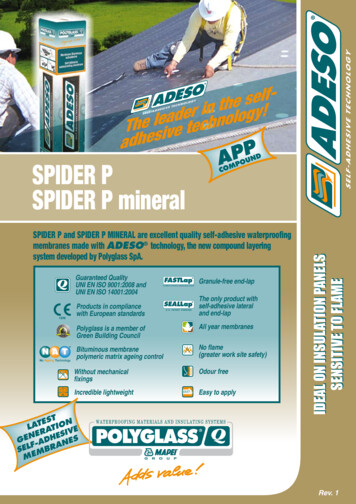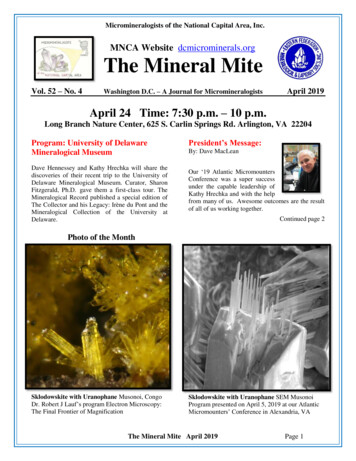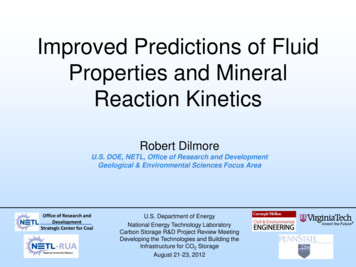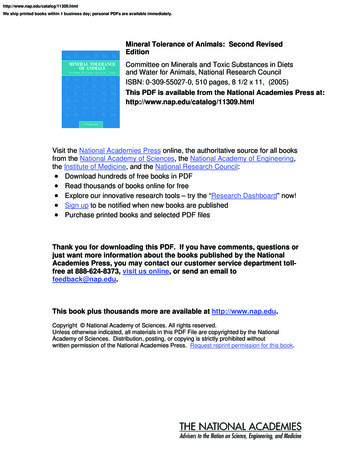
Transcription
http://www.nap.edu/catalog/11309.htmlWe ship printed books within 1 business day; personal PDFs are available immediately.Mineral Tolerance of Animals: Second RevisedEditionCommittee on Minerals and Toxic Substances in Dietsand Water for Animals, National Research CouncilISBN: 0-309-55027-0, 510 pages, 8 1/2 x 11, (2005)This PDF is available from the National Academies Press at:http://www.nap.edu/catalog/11309.htmlVisit the National Academies Press online, the authoritative source for all booksfrom the National Academy of Sciences, the National Academy of Engineering,the Institute of Medicine, and the National Research Council: Download hundreds of free books in PDF Read thousands of books online for free Explore our innovative research tools – try the “Research Dashboard” now! Sign up to be notified when new books are published Purchase printed books and selected PDF filesThank you for downloading this PDF. If you have comments, questions orjust want more information about the books published by the NationalAcademies Press, you may contact our customer service department tollfree at 888-624-8373, visit us online, or send an email tofeedback@nap.edu.This book plus thousands more are available at http://www.nap.edu.Copyright National Academy of Sciences. All rights reserved.Unless otherwise indicated, all materials in this PDF File are copyrighted by the NationalAcademy of Sciences. Distribution, posting, or copying is strictly prohibited withoutwritten permission of the National Academies Press. Request reprint permission for this book.
Mineral Tolerance of Animals: Second Revised L TOLERANCEOF ANIMALSS E C O N DR E V I S E DE D I T I O N ,2 0 0 5Committee on Minerals and Toxic Substances inDiets and Water for AnimalsBoard on Agriculture and Natural ResourcesDivision on Earth and Life StudiesCopyright National Academy of Sciences. All rights reserved.
Mineral Tolerance of Animals: Second Revised Editionhttp://www.nap.edu/catalog/11309.htmlTHE NATIONAL ACADEMIES PRESS 500 Fifth Street, N.W. Washington, DC 20001NOTICE: The project that is the subject of this report was approved by the Governing Board of theNational Research Council, whose members are drawn from the councils of the National Academy ofSciences, the National Academy of Engineering, and the Institute of Medicine. The members of thecommittee responsible for the report were chosen for their special competences and with regard for appropriate balance.This study was supported by Contract/Grant No. 223-01-2460 between the National Academy ofSciences and the Center for Veterinary Medicine of the U.S. Food and Drug Administration, Departmentof Health and Human Services. Any opinions, findings, conclusions, or recommendations expressed inthis publication are those of the author(s) and do not necessarily reflect the views of the organizations oragencies that provided support for the project.Library of Congress Cataloging-in-Publication DataMineral tolerance of animals / Committee on Minerals and Toxic Substances, Board on Agriculture andNatural Resources, Division on Earth and Life Studies.— 2nd rev. ed.p. cm.Rev. ed. of: Mineral tolerance of domestic animals / National Research Council (U.S.). Subcommittee onMineral Toxicity in Animals. 1980.Includes bibliographical references and index.ISBN 0-309-09654-5 (pbk.) — ISBN 0-309-55027-0 (pdf) 1. Veterinary toxicology. 2. Minerals inanimal nutrition. I. National Research Council (U.S.). Committee on Minerals and Toxic Substances. II.National Research Council (U.S.). Subcommittee on Mineral Toxicity in Animals. Mineral tolerance ofdomestic animals.SF757.5M56 2005636.089′59—dc222005024930Additional copies of this report are available from the National Academies Press, 500 Fifth Street, N.W.,Lockbox 285, Washington, DC 20055; (800) 624-6242 or (202) 334-3313 (in the Washington metropolitan area); Internet, http://www.nap.eduCopyright 2005 by the National Academy of Sciences. All rights reserved.Printed in the United States of AmericaCopyright National Academy of Sciences. All rights reserved.
Mineral Tolerance of Animals: Second Revised Editionhttp://www.nap.edu/catalog/11309.htmlThe National Academy of Sciences is a private, nonprofit, self-perpetuating society ofdistinguished scholars engaged in scientific and engineering research, dedicated to the furtherance of science and technology and to their use for the general welfare. Upon theauthority of the charter granted to it by the Congress in 1863, the Academy has a mandatethat requires it to advise the federal government on scientific and technical matters. Dr.Ralph J. Cicerone is president of the National Academy of Sciences.The National Academy of Engineering was established in 1964, under the charter of theNational Academy of Sciences, as a parallel organization of outstanding engineers. It isautonomous in its administration and in the selection of its members, sharing with the National Academy of Sciences the responsibility for advising the federal government. TheNational Academy of Engineering also sponsors engineering programs aimed at meetingnational needs, encourages education and research, and recognizes the superior achievements of engineers. Dr. Wm. A. Wulf is president of the National Academy of Engineering.The Institute of Medicine was established in 1970 by the National Academy of Sciences tosecure the services of eminent members of appropriate professions in the examination ofpolicy matters pertaining to the health of the public. The Institute acts under the responsibility given to the National Academy of Sciences by its congressional charter to be an adviserto the federal government and, upon its own initiative, to identify issues of medical care,research, and education. Dr. Harvey V. Fineberg is president of the Institute of Medicine.The National Research Council was organized by the National Academy of Sciences in1916 to associate the broad community of science and technology with the Academy’spurposes of furthering knowledge and advising the federal government. Functioning inaccordance with general policies determined by the Academy, the Council has become theprincipal operating agency of both the National Academy of Sciences and the NationalAcademy of Engineering in providing services to the government, the public, and the scientific and engineering communities. The Council is administered jointly by both Academiesand the Institute of Medicine. Dr. Ralph J. Cicerone and Dr. Wm. A. Wulf are chair and vicechair, respectively, of the National Research Council.www.national-academies.orgCopyright National Academy of Sciences. All rights reserved.
Mineral Tolerance of Animals: Second Revised ght National Academy of Sciences. All rights reserved.
Mineral Tolerance of Animals: Second Revised TEE ON MINERALS AND TOXIC SUBSTANCES INDIETS AND WATER FOR ANIMALSKIRK C. KLASING, Chair, University of California, DavisJESSE P. GOFF, U.S. Department of Agriculture, Agricultural Research Service,Ames, IowaJANET L. GREGER, University of Connecticut, StorrsJANET C. KING, Children’s Hospital Oakland Research Institute, Oakland, CaliforniaSANTOSH P. LALL, Institute for Marine Biosciences, National Research Council ofCanada, Halifax, Nova ScotiaXINGEN G. LEI, Cornell University, Ithaca, New YorkJAMES G. LINN, University of Minnesota, St. PaulFORREST H. NIELSEN, U.S. Department of Agriculture, Agricultural Research Service,Grand Forks, North DakotaJERRY W. SPEARS, North Carolina State University, RaleighStaffAUSTIN J. LEWIS, Study DirectorJAMIE S. JONKER, Study Director*DONNA LEE JAMEISON, Senior Program AssistantPEGGY TSAI, Research Associate*Through June 2004vCopyright National Academy of Sciences. All rights reserved.
Mineral Tolerance of Animals: Second Revised Editionhttp://www.nap.edu/catalog/11309.htmlBOARD ON AGRICULTURE AND NATURAL RESOURCESMAY R. BERENBAUM, Chair, University of Illinois, Urbana-ChampaignSANDRA J. BARTHOLMEY, University of Illinois at ChicagoROGER N. BEACHY, Donald Danforth Plant Science Center, St. Louis, MissouriH. H. CHENG, University of Minnesota, St. PaulW. R. (REG) GOMES, University of California, OaklandARTURO GOMEZ-POMPA, University of California, RiversidePERRY R. HAGENSTEIN, Institute for Forest Analysis, Planning, and Policy,Wayland, MassachusettsJEAN HALLORAN, Consumer Policy Institute/Consumers Union, Yonkers, New YorkHANS R. HERREN, Millennium Institute, Arlington, VirginiaDANIEL P. LOUCKS, Cornell University, Ithaca, New YorkWHITNEY MACMILLAN, Cargill, Incorporated, Minneapolis, MinnesotaBRIAN W. MCBRIDE, University of Guelph, Guelph, CanadaTERRY L. MEDLEY, E. I. duPont de Nemours & Co., Wilmington, DelawareOLE NIELSEN, Ontario Veterinary College, Spruce Grove, CanadaROBERT PAARLBERG, Wellesley College, Watertown, MassachusettsALICE N. PELL, Cornell University, Ithaca, New YorkBOBBY PHILLS, Florida A&M University, TallahasseePEDRO A. SANCHEZ, The Earth Institute at Columbia University, Palisades, New YorkSONYA B. SALAMON, University of Illinois, Urbana-ChampaignB. L. TURNER, II, Clark University, Worcester, MassachusettsTILAHUN D. YILMA, University of California, DavisJAW-KAI WANG, University of Hawaii, HonoluluStaffROBIN A. SCHOEN, DirectorCHARLOTTE KIRK BAER, Director*KAREN L. IMHOF, Administrative Assistant*Through October 2004viCopyright National Academy of Sciences. All rights reserved.
Mineral Tolerance of Animals: Second Revised ledgmentsDennis J. Blodgett, Virginia Tech University,Blacksburg, VAGerry F. Combs, USDA, Grand Forks, NDGail L. Czarnecki-Maulden, Nestle Purina Research,St. Joseph, MOL. Wayne Greene, Texas A&M University,Amarillo, TXPamela Henry Miles, University of Florida,Gainesville, FLMark P. Richards, USDA, ARS, Beltsville, MDKristi Smedley, Center for Regulatory Services,Woodbridge, VAPatricia A. Talcott, University of Idaho, Moscow, IDDuane E. Ullrey, Michigan State University, EastLansing, MIWilliam P. Weiss, The Ohio State University,Wooster, OHThe committee would like to thank Charlotte Kirk Baerand Robin Schoen, board directors, and Austin Lewis andJamie Jonker, program officers, for their cheerful and expertguidance during this project. The committee also wishes tothank Gretchen Hill and Marcia Carlson Shannon for assistance with the chapters on iron and zinc and KatherineMahaffey for helpful discussions on levels of minerals thatare of concern for human health. Finally, we greatly appreciate the help of Donna Jameison, Marina Peunova-Conner,and Peggy Tsai for their support of our communications,meetings, and writings.The sponsorship of this study by the Center for Veterinary Medicine of the U.S. Food and Drug Administration(FDA) is gratefully acknowledged. The support of the FDAliaison, William D. Price, was especially appreciated.This report has been reviewed in draft form by individuals chosen for their diverse perspectives and technical expertise, in accordance with procedures approved by the NRC’sReport Review Committee. The purpose of this independentreview is to provide candid and critical comments that willassist the institution in making its published reports as soundas possible and to ensure that the report meets institutionalstandards for objectivity, evidence, and responsiveness tothe study charge. The review comments and draft manuscript remain confidential to protect the integrity of the deliberative process. We wish to thank the following individuals for their review of this report:Although the reviewers listed above provided many constructive comments and suggestions, they were not asked toendorse the conclusions or recommendations nor did theysee the final draft of the report before its release. The reviewof this report was overseen by Gary L. Cromwell, Universityof Kentucky. Appointed by the National Research Council,he was responsible for making certain that an independentexamination of the report was carried out in accordance withinstitutional procedures and that all review comments werecarefully considered. Responsibility for the final content ofthis report rests entirely with the authoring committee andthe institution.Clarence B. Ammerman, University of Florida,Gainesville, FLviiCopyright National Academy of Sciences. All rights reserved.
Mineral Tolerance of Animals: Second Revised ght National Academy of Sciences. All rights reserved.
Mineral Tolerance of Animals: Second Revised ewas still relevant, but that this historic foundation needed tobe reevaluated in the context of newer information on themethods of mineral analysis, mechanisms of homeostasisand toxicity, and appropriate indices of animal health andwell-being. Consequently, a reanalysis of the historic literature is synthesized with the recent literature to form the recommendations in this report. This edition considers a greaterbreadth of animal species than the past edition and expandsthe coverage on the metabolism and mechanisms of toxicityof minerals, methods and problems in mineral analysis, andthe relationships between mineral exposure of animals andthe mineral levels in animal products destined for humanconsumption. New chapters provide additional focus onacid-base balance, nitrates, and water quality. Finally, thisedition has placed increased emphasis on the safety of animal products in the human diet as criteria for setting maximum tolerable levels of minerals in the feed and water offarm animals.The recommendations in the 1980 report have beenwidely cited and served as the basis of decisions made byregulatory agencies and by practicing nutritionists responsible for the formulation of animal diets. The previous reporthas also been used extensively in teaching, r
THE NATIONAL ACADEMIES PRESS 500 Fifth Street, N.W. Washington, DC 20001 NOTICE: The project that is the subject of this report was approved by the Governing Board of the


